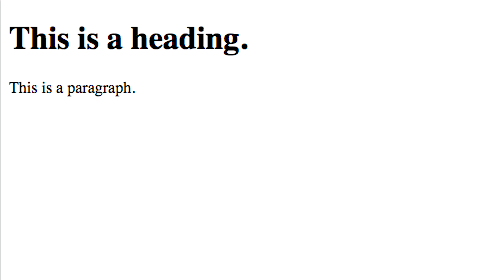HTML is the industry-standard language for building websites and web applications. A server delivers an HTML file to your computer every time you visit a website, and your browser interprets and displays the information contained in that file. In fact, everything you're reading right now is just data that was saved in an HTML file and transmitted to your browser.
The best part about HTML is that it's a simple language to pick up.
Most people can learn the basics of HTML in just a few hours, and once you have a strong HTML foundation, you can go on to more advanced languages like CSS and JavaScript.
This HTML tutorial for beginners will provide you an overview of HTML, look at the essential building parts of HTML including tags, elements, and attributes, and walk you through creating your first HTML page with a step-by-step tutorial. By the end of this tutorial, you should have all of the necessary skills to begin working on your own HTML projects.
What Is HTML and How Does It Work?
HTML stands for HyperText Markup Language, which is a phrase that many novices find incomprehensible. Examining the meaning of each term is the best method to explain HTML.
HyperText is a type of text that includes hyperlinks to other texts. Hypertext is used every time you click on a highlighted or underlined link that sends you to another page. A "web" of pages begins to form as more and more pages use hypertext to link to one another. This is where the name "World Wide Web" comes from.
The specific symbols or codes added into a document to tell the web browser how to display the document data are referred to as markup. Markup code, for example, can tell the browser to display a phrase in bold or italic text, or which portions of the document are headings and which are paragraphs. Markup code is used by a variety of languages, including HTML.
The term "language" relates to the idea of a uniform code. When writing HTML, everyone must follow specific norms, just like when speaking a conventional language. This is so that the code can be understood and interpreted by all browsers. There are numerous programming languages, and you may be familiar with some of the most popular ones, such as Java, Python, and Ruby. Every language has its own set of rules, and many languages may be combined with HTML to build incredible websites and applications.
How Does HTML Relate To Other Programming Languages?
If you've done any web development or design study, you've almost certainly come across articles or manuals that mention CSS and JavaScript.
The three main languages used to generate most web pages are HTML, CSS, and JavaScript. Each language serves a different purpose and has its own set of rules, yet they all work together to provide content, design, and functionality to websites.
HTML, as previously said, is the foundation of any website. The HTML code comprises the site's core structure and content, including all text, links, tables, picture links, and other similar features.
CSS (Cascading Style Sheets) is used to determine the page's design, including factors like the size and appearance of each element. You can use CSS to change things like the font style, the page's background color, and the width of the border around components on the page.
JavaScript is a more advanced language for creating interactive features on your website. JavaScript edits your original HTML code when you hover your cursor over an image on a website and the image morphs or changes. JavaScript is also used when you click on a product on a shopping website and your shopping cart immediately updates.
CSS and JavaScript can enhance a site's design and functionality, but without HTML, there will be no site at all. In reality, even if the CSS and JavaScript code is broken, most websites will still show HTML data.
What Does HTML Code Look Like?
HTML code resembles plain text in appearance. Angle brackets are the most recognizable characteristic in HTML code. The markup code that directs the browser on how to display the document data is enclosed by these angle brackets.
Here’s an example of some simple HTML code:
<!DOCTYPE html>
<html>
<head>
<title>Page Title</title>
</head>
<body>
<h1>This is a heading.</h1>
<p>This is a paragraph.</p>
</body>
</html>
If you save this code into a text file with the filename “test.html” and open it in your browser, it should display a page like this:
 You can use the HTML tutorial, which is widely available on the web and is free, to gain a better understanding of python and certain strategies.
You can use the HTML tutorial, which is widely available on the web and is free, to gain a better understanding of python and certain strategies.
Comments
Post a Comment